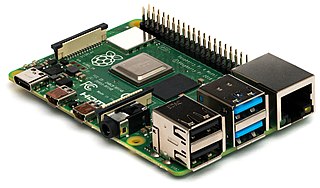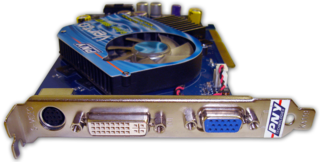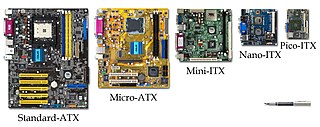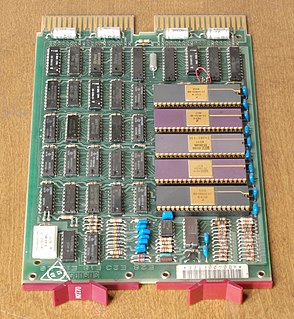
A motherboard is the main printed circuit board (PCB) in general-purpose computers and other expandable systems. It holds and allows communication between many of the crucial electronic components of a system, such as the central processing unit (CPU) and memory, and provides connectors for other peripherals. Unlike a backplane, a motherboard usually contains significant sub-systems, such as the central processor, the chipset's input/output and memory controllers, interface connectors, and other components integrated for general use.

A microcomputer is a small, relatively inexpensive computer with a microprocessor as its central processing unit (CPU). It includes a microprocessor, memory and minimal input/output (I/O) circuitry mounted on a single printed circuit board (PCB). Microcomputers became popular in the 1970s and 1980s with the advent of increasingly powerful microprocessors. The predecessors to these computers, mainframes and minicomputers, were comparatively much larger and more expensive. Many microcomputers are also personal computers.

A desktop computer is a personal computer designed for regular use at a single location on or near a desk or table due to its size and power requirements. The most common configuration has a case that houses the power supply, motherboard (a printed circuit board with a microprocessor as the central processing unit, memory, bus, and other electronic components, disk storage ; a keyboard and mouse for input; and a computer monitor, speakers, and, often, a printer for output. The case may be oriented horizontally or vertically and placed either underneath, beside, or on top of a desk.

A video card is an expansion card which generates a feed of output images to a display device. Frequently, these are advertised as discrete or dedicated graphics cards, emphasizing the distinction between these and integrated graphics. At the core of both is the graphics processing unit (GPU), which is the main part that does the actual computations, but should not be confused with the video card as a whole, although "GPU" is often used as a metonymic shorthand to refer to video cards.

The Big Board (1980) and Big Board II (1982) were Z80 based single-board computers designed by Jim Ferguson. They provided a complete CP/M compatible computer system on a single printed circuit board, including CPU, memory, disk drive interface, keyboard and video monitor interface. The printed circuit board was sized to match the Shugart 801 or 851 floppy drive. This allowed attachment to up to two 8 inch or 5 1/4 inch floppy disk drives. The Big Board II added a SASI interface which could be used to drive hard drives, enhancements to system speed and enhancements to the terminal interface.

Southwest Technical Products Corporation, or SWTPC, was a US producer of electronic kits, and later complete computer systems. It was incorporated in 1967 in San Antonio, Texas, succeeding the 1964 DEMCO. Around 1990, SWTPC became Point Systems, before ceasing a few years later.

The Apple IIc, the fourth model in the Apple II series of personal computers, is Apple Computer’s first endeavor to produce a portable computer. The result was a 7.5 lb (3.4 kg) notebook-sized version of the Apple II that could be transported from place to place — a portable alternative and complement to the Apple IIe. The c in the name stood for compact, referring to the fact it was essentially a complete Apple II computer setup squeezed into a small notebook-sized housing. While sporting a built-in floppy drive and new rear peripheral expansion ports integrated onto the main logic board, it lacks the internal expansion slots and direct motherboard access of earlier Apple II models, making it a closed system like the Macintosh. However, that was the intended direction for this model — a more appliance-like machine, ready to use out of the box, requiring no technical know-how or experience to hook up and therefore attractive to first-time users.

In a computer system, a chipset is a set of electronic components in an integrated circuit known as a "Data Flow Management System" that manages the data flow between the processor, memory and peripherals. It is usually found on the motherboard. Chipsets are usually designed to work with a specific family of microprocessors. Because it controls communications between the processor and external devices, the chipset plays a crucial role in determining system performance.

MicroBee was a series of networkable home computers by Applied Technology, which became publicly listed company MicroBee Systems Limited soon after its release.

A computer case, also known as a computer chassis, tower, system unit, or cabinet, is the enclosure that contains most of the components of a personal computer.
The Acorn Business Computer (ABC) was a series of microcomputers announced at the end of 1983 by the British company Acorn Computers. The series of eight computers was aimed at the business, research and further education markets. Launched at the Personal Computer World Show in September 1984, having been under development for "about a year" and having been undergoing field trials from May 1984, the range "understandably attracted a great deal of attention" and was favourably received by some commentators. However, the ABC range was cancelled before any of the models were shipped to customers. The ABC 210 was subsequently relaunched as the Acorn Cambridge Workstation, sold in modest numbers to academic and scientific users.

Small Form Factor is a term used for desktop computers, and their enclosures and motherboards, to indicate that they are designed in accordance with one of several standardized computer form factors intended to minimize the volume and footprint of a desktop computer compared to the standard ATX form factor.
Pravetz were Bulgarian computers, manufactured mainly in the town of Pravetz. Some components and software were produced in Stara Zagora, Plovdiv, and other Bulgarian cities.

The Apple II Plus is the second model of the Apple II series of personal computers produced by Apple Computer, Inc. It was sold from June 1979 to December 1982. Approximately 380,000 II Pluses were sold during its four years in production before being replaced by the IIe in 1983.

The Visual 50 is a terminal created by Visual Technology, Inc., which was located in Tewksbury, Massachusetts. Visual's slogan was "See for yourself". It merged with White Pine Software in 1993, which became CU-SeeMe Networks, in turn absorbed into RadVision in 2001.

The British Broadcasting Corporation Microcomputer System, or BBC Micro, is a series of microcomputers and associated peripherals designed and built by the Acorn Computer company in the 1980s for the BBC Computer Literacy Project, operated by the British Broadcasting Corporation. Designed with an emphasis on education, it was notable for its ruggedness, expandability, and the quality of its operating system. An accompanying 1982 television series, The Computer Programme, featuring Chris Serle learning to use the machine, was broadcast on BBC2.

Computer hardware includes the physical parts of a computer, such as the case, central processing unit (CPU), monitor, mouse, keyboard, computer data storage, graphics card, sound card, speakers and motherboard.
This glossary of computer hardware terms is a list of definitions of terms and concepts related to computer hardware, i.e. the physical and structural components of computers, architectural issues, and peripheral devices.

The Olivetti M20 is a Zilog Z8000 based computer from Olivetti introduced in 1982. Although it offered good performance, it suffered from a lack of software due to its use of the Z8000 processor and custom operating system, PCOS. The company introduced an IBM PC compatible in January 1984 and the M20 line was phased out.

















